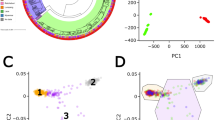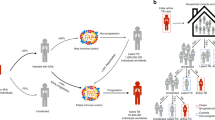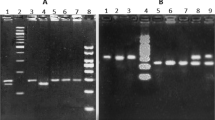Abstract
We analyzed two West African samples (Guinea-Bissau: n=289 cases and 322 controls; The Gambia: n=240 cases and 248 controls) to evaluate single-nucleotide polymorphisms (SNPs) in Epiregulin (EREG) and V-ATPase (T-cell immune regulator 1 (TCIRG1)) using single and multilocus analyses to determine whether previously described associations with pulmonary tuberculosis (PTB) in Vietnamese and Italians would replicate in African populations. We did not detect any significant single locus or haplotype associations in either sample. We also performed exploratory pairwise interaction analyses using Visualization of Statistical Epistasis Networks (ViSEN), a novel method to detect only interactions among multiple variables, to elucidate possible interaction effects between SNPs and demographic factors. Although we found no strong evidence of marginal effects, there were several significant pairwise interactions that were identified in either the Guinea-Bissau or the Gambian samples, two of which replicated across populations. Our results indicate that the effects of EREG and TCIRG1 variants on PTB susceptibility, to the extent that they exist, are dependent on gene–gene interactions in West African populations as detected with ViSEN. In addition, epistatic effects are likely to be influenced by inter- and intra-population differences in genetic or environmental context and/or the mycobacterial lineages causing disease.
This is a preview of subscription content, access via your institution
Access options
Subscribe to this journal
Receive 6 digital issues and online access to articles
$119.00 per year
only $19.83 per issue
Buy this article
- Purchase on Springer Link
- Instant access to full article PDF
Prices may be subject to local taxes which are calculated during checkout



Similar content being viewed by others
References
World Health Organization (WHO). Global Tuberculosis Report 2013. WHO: Geneva, 2013, Available from: http://apps.who.int/iris/bitstream/10665/91355/1/9789241564656_eng.pdf.
Frieden TR, Sterling TR, Munsiff SS, Watt CJ, Dye C . Tuberculosis. Lancet 2003; 362: 887–899.
Sirugo G, Hennig BJ, Adeyemo AA, Matimba A, Newport MJ, Ibrahim ME et al. Genetic studies of African populations: an overview on disease susceptibility and response to vaccines and therapeutics. Hum Genet 2008; 123: 557–598.
Stein CM, Baker AR . Tuberculosis as a complex trait: impact of genetic epidemiological study design. Mamm Genome 2010; 22: 91–99.
Caws M, Thwaites G, Dunstan S, Hawn TR, Lan NT, Thuong NT et al. The influence of host and bacterial genotype on the development of disseminated disease with Mycobacterium tuberculosis. PLoS Pathog 2008; 4: e1000034.
Salie M, van der ML, Moller M, Daya M, van der Spuy GD, van Helden PD et al. Associations between human leukocyte antigen class I variants and the Mycobacterium tuberculosis subtypes causing disease. J Infect Dis 2013; 209: 216–223.
Thye T, Meyer CG . Human genetic variability and susceptibility to pulmonary TB. In: Lange C, Migliori GB, (eds). Tuberculosis European Respiratory Society: Sheffield 2012, pp 38–58.
Thuong NT, Hawn TR, Chau TT, Bang ND, Yen NT, Thwaites GE et al. Epiregulin (EREG) variation is associated with susceptibility to tuberculosis. Genes Immun 2012; 13: 275–281.
Capparelli R, Palumbo D, Iannaccone M, Iannelli D . Human V-ATPase gene can protect or predispose the host to pulmonary tuberculosis. Genes Immun 2009; 10: 641–646.
Toyoda H, Komurasaki T, Uchida D, Takayama Y, Isobe T, Okuyama T et al. Epiregulin. A novel epidermal growth factor with mitogenic activity for rat primary hepatocytes. J Biol Chem 1995; 270: 7495–7500.
Thuong NT, Dunstan SJ, Chau TT, Thorsson V, Simmons CP, Quyen NT et al. Identification of tuberculosis susceptibility genes with human macrophage gene expression profiles. PLoS Pathog 2008; 4: e1000229.
Nalbandian A, Yan BS, Pichugin A, Bronson RT, Kramnik I . Lung carcinogenesis induced by chronic tuberculosis infection: the experimental model and genetic control. Oncogene 2009; 28: 1928–1938.
Toei M, Saum R, Forgac M . Regulation and isoform function of the V-ATPases. Biochemistry 2010; 49: 4715–4723.
Hinton A, Bond S, Forgac M . V-ATPase functions in normal and disease processes. Pflugers Arch 2009; 457: 589–598.
Heinemann T, Bulwin GC, Randall J, Schnieders B, Sandhoff K, Volk HD et al. Genomic organization of the gene coding for TIRC7, a novel membrane protein essential for T cell activation. Genomics 1999; 57: 398–406.
Li YP, Chen W, Stashenko P . Molecular cloning and characterization of a putative novel human osteoclast-specific 116-kDa vacuolar proton pump subunit. Biochem Biophys Res Commun 1996; 218: 813–821.
Scott BB, Chapman CG . The putative 116 kDa osteoclast specific vacuolar proton pump subunit has ubiquitous tissue distribution. Eur J Pharmacol 1998; 346: R3–R4.
Del Fattore A, Cappariello A, Teti A . Genetics, pathogenesis and complications of osteopetrosis. Bone 2008; 42: 19–29.
Utku N, Heinemann T, Tullius SG, Bulwin GC, Beinke S, Blumberg RS et al. Prevention of acute allograft rejection by antibody targeting of TIRC7, a novel T cell membrane protein. Immunity 1998; 9: 509–518.
Singh CR, Moulton RA, Armitige LY, Bidani A, Snuggs M, Dhandayuthapani S et al. Processing and presentation of a mycobacterial antigen 85B epitope by murine macrophages is dependent on the phagosomal acquisition of vacuolar proton ATPase and in situ activation of cathepsin D. J Immunol 2006; 177: 3250–3259.
Sturgill-Koszycki S, Schlesinger PH, Chakraborty P, Haddix PL, Collins HL, Fok AK et al. Lack of acidification in Mycobacterium phagosomes produced by exclusion of the vesicular proton-ATPase. Science 1994; 263: 678–681.
Kolonko M, Geffken AC, Blumer T, Hagens K, Schaible UE, Hagedorn M . WASH-driven actin polymerization is required for efficient mycobacterial phagosome maturation arrest. Cell Microbiol 2013; 16: 232–246.
Wong D, Bach H, Sun J, Hmama Z, Av-Gay Y . Mycobacterium tuberculosis protein tyrosine phosphatase (PtpA) excludes host vacuolar-H+-ATPase to inhibit phagosome acidification. Proc Natl Acad Sci USA 2011; 108: 19371–19376.
Conboy IM, Manoli D, Mhaiskar V, Jones PP . Calcineurin and vacuolar-type H+-ATPase modulate macrophage effector functions. Proc Natl Acad Sci USA 1999; 96: 6324–6329.
Ryckman KK, Jiang L, Li C, Bartlett J, Haines JL, Williams SM . A prevalence-based association test for case-control studies. Genet Epidemiol 2008; 32: 600–605.
Hu T, Sinnott-Armstrong NA, Kiralis JW, Andrew AS, Karagas MR, Moore JH . Characterizing genetic interactions in human disease association studies using statistical epistasis networks. BMC Bioinformatics 2011; 12: 364.
Hu T, Chen Y, Kiralis JW, Moore JH . ViSEN: methodology and software for visualization of statistical epistasis networks. Genet Epidemiol 2013; 37: 283–285.
Greene CS, Penrod NM, Williams SM, Moore JH . Failure to replicate a genetic association may provide important clues about genetic architecture. PLoS ONE 2009; 4: e5639.
Coussens AK, Wilkinson RJ, Nikolayevskyy V, Elkington PT, Hanifa Y, Islam K et al. Ethnic variation in inflammatory profile in tuberculosis. PLoS Pathog 2013; 9: e1003468.
Pareek M, Evans J, Innes J, Smith G, Hingley-Wilson S, Lougheed KE et al. Ethnicity and mycobacterial lineage as determinants of tuberculosis disease phenotype. Thorax 2013; 68: 221–229.
Thye T, Niemann S, Walter K, Homolka S, Intemann CD, Chinbuah MA et al. Variant G57E of mannose binding lectin associated with protection against tuberculosis caused by Mycobacterium africanum but not by M. tuberculosis. PLoS ONE 2011; 6: e20908.
Olesen R, Wejse C, Velez DR, Bisseye C, Sodemann M, Aaby P et al. DC-SIGN (CD209), pentraxin 3 and vitamin D receptor gene variants associate with pulmonary tuberculosis risk in West Africans. Genes Immun 2007; 8: 456–467.
Morris GA, Edwards DR, Hill PC, Wejse C, Bisseye C, Olesen R et al. Interleukin 12B (IL12B) genetic variation and pulmonary tuberculosis: a study of cohorts from The Gambia, Guinea-Bissau, United States and Argentina. PLoS ONE 2011; 6: e16656.
Gustafson P, Gomes VF, Vieira CS, Rabna P, Seng R, Johansson P et al. Tuberculosis in Bissau: incidence and risk factors in an urban community in sub-Saharan Africa. Int J Epidemiol 2004; 33: 163–172.
Purcell S, Neale B, Todd-Brown K, Thomas L, Ferreira MA, Bender D et al. PLINK: a tool set for whole-genome association and population-based linkage analyses. Am J Hum Genet 2007; 81: 559–575.
Barrett JC, Fry B, Maller J, Daly MJ . Haploview: analysis and visualization of LD and haplotype maps. Bioinformatics 2005; 21: 263–265.
StataCorp. Stata Statistical Software. [Release 11]. StataCorp LP: College Station, TX, 2009.
Zamar D, McNeney B, Graham J . elrm: software implementation exact-like inference for logistic regression models. J Statist Softw 2007; 21: 21.
R Core Team. R: A Language and Environment for Statistical Computing. R Foundation for Statistical Computing: Vienna, Austria, 2013.
Grady BJ, Torstenson E, Dudek SM, Giles J, Sexton D, Ritchie MD . Finding unique filter sets in PLATO: a precursor to efficient interaction analysis in GWAS data. In: Pacific Symp Biocomputing 2010. World Scientific Publishing, pp 315–326.
Acknowledgements
This work was supported by the Medical Research Council (MRC UK) award G0000690 to GS and by grants from the Danish Medical Research Council, the Danish Society of Respiratory Medicine and the Danish Council of Development Research to CW and LJØ. MJW and SMW were partially supported by NIH Grant P20 GM103534.
Author information
Authors and Affiliations
Corresponding authors
Ethics declarations
Competing interests
The authors declare no conflict of interest.
Additional information
Supplementary Information accompanies this paper on Genes and Immunity website
Supplementary information
Rights and permissions
About this article
Cite this article
White, M., Tacconelli, A., Chen, J. et al. Epiregulin (EREG) and human V-ATPase (TCIRG1): genetic variation, ethnicity and pulmonary tuberculosis susceptibility in Guinea-Bissau and The Gambia. Genes Immun 15, 370–377 (2014). https://doi.org/10.1038/gene.2014.28
Received:
Revised:
Accepted:
Published:
Issue Date:
DOI: https://doi.org/10.1038/gene.2014.28
This article is cited by
-
An epistatic interaction between pre-natal smoke exposure and socioeconomic status has a significant impact on bronchodilator drug response in African American youth with asthma
BioData Mining (2020)
-
Polymorphism in the EREG gene confers susceptibility to tuberculosis
BMC Medical Genetics (2019)
-
Genomics of Human Pulmonary Tuberculosis: from Genes to Pathways
Current Genetic Medicine Reports (2017)



